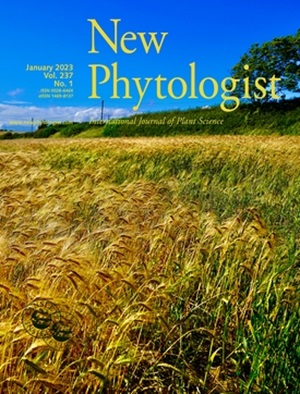林分密度和当地气候驱动GPP对地上木质生物量的分配
IF 8.3
1区 生物学
Q1 PLANT SCIENCES
引用次数: 0
摘要
光合产物在各种森林碳库之间的分配是调节长期碳固存的关键过程,尤其是地上木质生物质碳(AGBC)的分配,由于其停留时间较慢,在全球碳循环中发挥着巨大的作用。然而,从历史上看,直接估计总初级生产力(GPP)中流向AGBC的部分既困难又耗时,给我们留下了持续的不确定性。我们使用位于通量塔的树木年轮年表的广泛数据集来评估AGBC和GPP之间的耦合,计算分配给AGBC的固定碳比例,并了解这一比例变化的驱动因素。我们发现年AGBC和GPP很少相关,而且年AGBC只占固定碳的一小部分(约9%)。不同立地的林分密度和立地气候的差异决定了这一比例的差异。在干旱期间,年AGBC被抑制了约30%,此后一直低于平均水平。这些结果表明,假设GPP相对平稳地分配给木质生物质和其他植物组织,可能会导致不同植物池中模拟的碳积累和碳停留时间的系统性偏差。本文章由计算机程序翻译,如有差异,请以英文原文为准。
Stand density and local climate drive allocation of GPP to aboveground woody biomass
- The partitioning of photosynthate among various forest carbon pools is a key process regulating long-term carbon sequestration, with allocation to aboveground woody biomass carbon (AGBC) in particular playing an outsized role in the global carbon cycle due to its slow residence time. However, directly estimating the fraction of gross primary productivity (GPP) that goes to AGBC has historically been difficult and time-consuming, leaving us with persistent uncertainties.
- We used an extensive dataset of tree-ring chronologies co-located at flux towers to assess the coupling between AGBC and GPP, calculate the fraction of fixed carbon that is allocated to AGBC, and understand the drivers of variability in this fraction.
- We found that annual AGBC and GPP were rarely correlated, and that annual AGBC represented only a small fraction (c. 9%) of fixed carbon. This fraction varied considerably across sites and was driven by differences in stand density and site climate. Annual AGBC was suppressed by c. 30% during drought and remained below average for years afterward.
- These results imply that assumptions of relatively stationary allocation of GPP to woody biomass and other plant tissues could lead to systematic biases in modeled carbon accumulation in different plant pools and thus in carbon residence time.
求助全文
通过发布文献求助,成功后即可免费获取论文全文。
去求助
来源期刊

New Phytologist
生物-植物科学
自引率
5.30%
发文量
728
期刊介绍:
New Phytologist is an international electronic journal published 24 times a year. It is owned by the New Phytologist Foundation, a non-profit-making charitable organization dedicated to promoting plant science. The journal publishes excellent, novel, rigorous, and timely research and scholarship in plant science and its applications. The articles cover topics in five sections: Physiology & Development, Environment, Interaction, Evolution, and Transformative Plant Biotechnology. These sections encompass intracellular processes, global environmental change, and encourage cross-disciplinary approaches. The journal recognizes the use of techniques from molecular and cell biology, functional genomics, modeling, and system-based approaches in plant science. Abstracting and Indexing Information for New Phytologist includes Academic Search, AgBiotech News & Information, Agroforestry Abstracts, Biochemistry & Biophysics Citation Index, Botanical Pesticides, CAB Abstracts®, Environment Index, Global Health, and Plant Breeding Abstracts, and others.
 求助内容:
求助内容: 应助结果提醒方式:
应助结果提醒方式:


